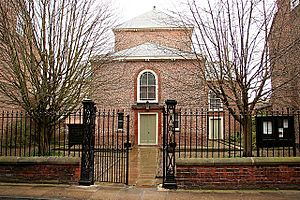York Unitarian Chapel facts for kids
The York Unitarian Chapel is a historic building located on St. Saviourgate in York, England. It is a place of worship for Unitarians, who are part of the General Assembly of Unitarian and Free Christian Churches in Britain. This group helps connect different Unitarian churches.
About York Unitarian Chapel
This chapel is quite old, built in 1692 or even earlier. It has a unique shape, like a Greek cross, which means it has four arms of equal length. The building is very important historically, so it is listed as a Grade II* building. This means it is a particularly important building of more than special interest. It is also believed to be one of the first large brick buildings in York that used bricks to support the weight of the walls and roof.
Important Supporters
A very important person who helped the Chapel was Lady Sarah Hewley. She was a Protestant dissenter, which means she was a Christian who chose not to follow the main Church of England. Lady Hewley was the widow of Sir John Hewley, who was a Member of Parliament (MP). An MP is a person elected to represent people in the country's government.
Lady Hewley also started special homes called almshouses in Tanner Row in York. These homes provided shelter for people in need. Later, in 1839, these almshouses were moved because of the railway and became the Lady Hewley's Almshouses that you can see today on St Saviourgate.
Famous Leaders
The most well-known minister (or leader) of the Chapel was Charles Wellbeloved. He first worked as an assistant to another minister, Rev. Newcome Cappe, and then became the main minister until he passed away in 1858.
Charles Wellbeloved was involved in many important projects in York. For example, he helped save the historic York city walls from being taken apart for building materials. He also worked to improve conditions at the York County Lunatic Asylum, which was a hospital for people with mental health conditions. He helped stop unfair or harmful practices there.
Additionally, he started the York Mechanics' Institute, which was a place where working people could learn new skills. He also wrote a guide to the famous York Minster cathedral and helped raise money after a fire damaged a screen inside the Minster. Charles Wellbeloved was also the Principal of Manchester College, which was one of the special schools called dissenting academies. These schools trained ministers and offered higher education to other students.


